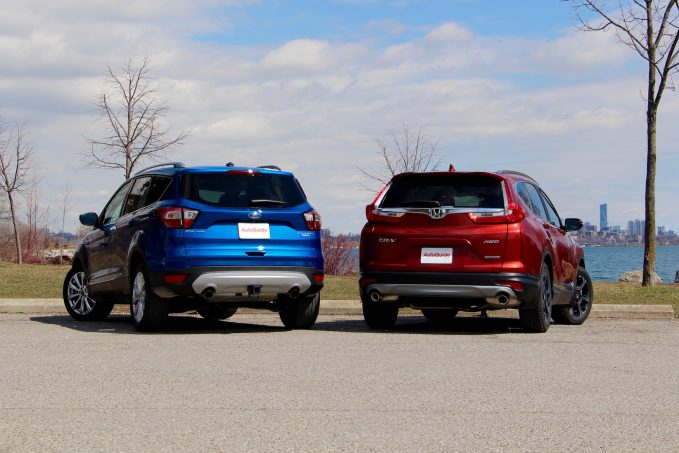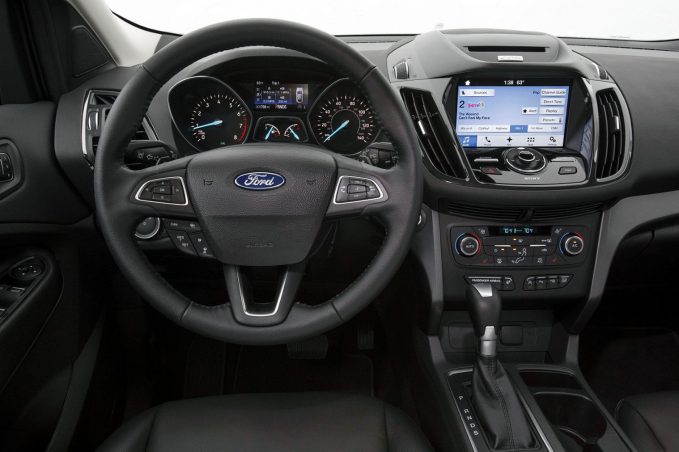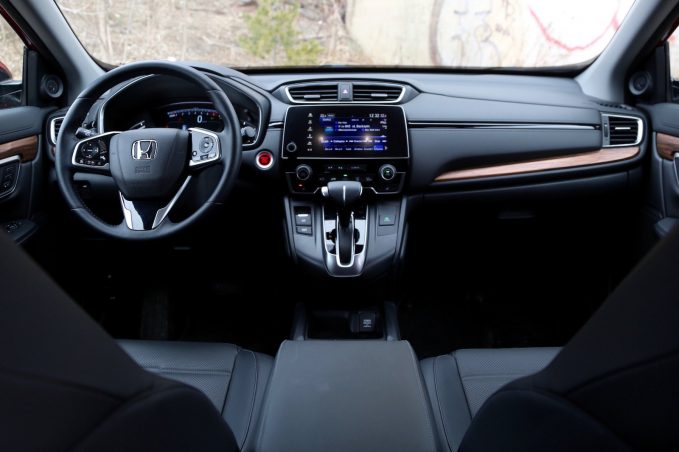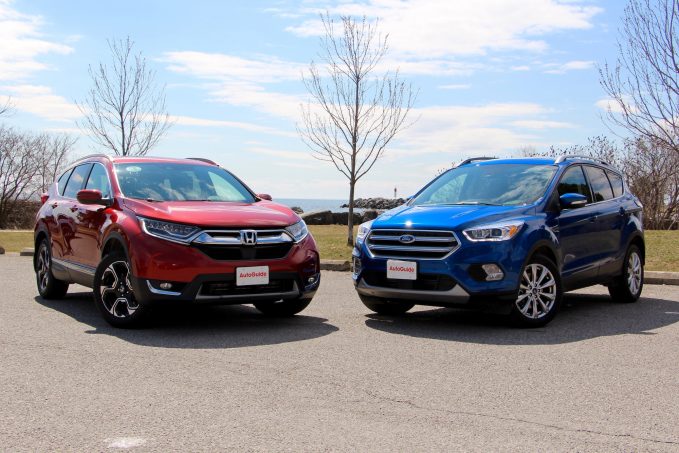The first comparison we set up for our Honda CR-V long-term tester is the Ford Escape. It was refreshed for 2017 but remains a sporty little CUV that provides a dose of excitement along with its practicality.
The CR-V, on the other hand, is completely new for 2017 and appeals more to our logical sides with its efficiency and value.
With the Escape packing the punchy 2.0-litre EcoBoost and the CR-V a thrifty 1.5-litre turbo, the decision might ultimately come down to whether you prefer more sport or utility in your compact crossover.
Compare Specs
Styling
I don’t normally go anywhere near the topic of styling, but in this case, I’ll break my silence. The CR-V isn’t exactly ugly and it has a handsome profile, but it’s got a lot going on in that grille and the tailgate seems like it’s trying to compete for attention with the front. In contrast, the Escape has a clean, simple flow all the way around, and takes advantage of its tidy dimensions with a sporty, poised look.
Inside, the tables are turned, and it is the Escape that seems fussy and a bit confusing compared to the CR-V’s clean, straightforward layout.
Get the Flash Player to see this player.
Power & Efficiency
When it comes to power, it’s not really a fair fight. We asked for fully loaded models, and that means Ford sent us the Escape Titanium with the 2.0L turbo four pumping out 245 horsepower and 275 lb-ft of torque. Unlike many recent turbocharged powerplants that deliver maximum torque before 2,000 rpm, the 2.0 Ecoboost reaches peak torque at 3,000 rpm, and you certainly feel it when it comes on, surging ahead a bit wildly for a little family vehicle.
The six-speed transmission keeps up well enough, but it can’t match the smarts, smoothness, and responsiveness of Honda’s CVT. However, if you like the feel of running through set gears, it has that going for it, with paddle shifters to keep you amused if you’re so inclined.
SEE MORE: 2017 Honda CR-V Long-Term Test Introduction
Then again, the transmission really doesn’t need to be that clever, because 245 hp is more than enough in any situation, even carrying around 3,765 pounds (1,708 kg?) plus whatever stuff and people are in it, so it leaps away from lights and easily steps out for passing moves at highway speeds without a worry.
Of course, all that enthusiasm comes at a price, and that price is paid at the pumps. The EPA estimates the Escape 2.0 Ecoboost with AWD at 20 mpg in the city, 27 on the highway, and 23 combined (11.5 L/100 km in the city, 8.7 on the highway, and 10.2 combined), and we haven’t yet broken out of the teens in our time with it. If efficiency is top of mind, Ford offers a couple of thriftier engine choices, one of them a 1.5-liter turbo just like the CR-V, but it has less power, torque, and worse fuel consumption than the CR-V’s turbo.
After many years resisting the tide of turbocharging, Honda has finally come out with a mainstream small-displacement turbo for its mainstream cars, and this 1.5-liter turbo first appeared in a Civic and now powers the CR-V.
I don’t particularly love this engine, especially when driven back to back with the Escape’s 2.0 Ecoboost, but it gets the job done.
You’ll rarely feel the full fury of its 190 horsepower since they only arrive at 5,600 rpm, but it’s preceded by such a whining racket that you are more likely to lift off the throttle and accept gentle acceleration. The 179 lb-ft are best described as adequate, thankfully arriving at 2,000 rpm and available right up to 5,000 rpm, though you are not likely to get even that far up that tach if you prefer a quiet cabin.
SEE MORE: 2017 Ford Escape Review
Don’t get me wrong, the CR-V isn’t actually slow, it’s simply unpleasant to push it very hard. Keep it in Econ mode and accelerate gently, and you can expect to see about 27 mpg in the city, 33 on the highway, and 29 combined (8.7 L/100 km city, 7.2 highway, and 8.0 combined).
But if you switch off the Econ mode, drop the transmission into Sport, and can put up with a bit of a commotion, the CR-V can get moving, especially with all four wheels powering it forward in AWD trims. Hitting 60 mph (or 100 km/h) should take about 8 seconds. The transmission is continuously variable, meaning it is quick and responsive and completely smooth, but can also drone at higher rpms, which this small engine requires if you tend to move along with traffic in the fast lane.
Comfort and Driving Dynamics
Crossovers may get a bad rap for being dull to drive, but that misses the entire point of the segment. Average drivers want something that’s easy to load, easy to get into and out of, easy to drive and easy to park. That is what matters.
To that end, the CR-V gets it so right. The steering is light, natural, and responsive. Throttle, same. Brake, ditto.
Impressively, there is another layer of quality underpinning the driving experience, with a platform that feels incredibly solid, and the suspension carefully designed to afford maximum compliance and comfort without being sloppy or unnerving when taking a turn at higher speeds or having to execute an emergency avoidance maneuver.
Every bit of its driving experience screams “family hauler” and does it superbly.
The Escape, in this Titanium trim with its 18-inch wheels, strays perhaps a bit too far to the sporty end of the spectrum. While the decent handling is appreciated, I rediscovered how poor the roads are on some of the secondary roads along my route home, the lumpy, rutted pavement jarring the cabin a little too frequently.
While the cabin is quieter at highway speeds, thanks largely to the more powerful engine that doesn’t need to work so hard, the Escape does seem to have more vibrations and clunks that seem to be completely dialed out of the CR-V.
Cargo & Passenger Space
Though an inch shorter than the Escape in wheelbase, the CR-V outstretches it by a couple inches in length, translating into that generous trunk of almost 40 cubic feet 39.2/75.8 cu-ft (1,065 L), growing to 75 39.2/75.8 cu-ft (2,146 L) when dropping the rear seats, which you can do using the handy levers at the side of the cargo bay.
SEE MORE: Honda CR-V Wins 2017 AutoAfterWorld.com Utility Vehicle of the Year Award
And the rear seat is just ridiculously spacious. Considering its wheelbase is shorter than the Escape, I just don’t understand where all this legroom comes from.
The front row is just as spacious, and the seats are comfortable, but there is something just a touch awkward about the driving position, needing perhaps just a bit more reach to the telescopic steering wheel.
The front seat in the Escape is spacious and airy, with heated seat and steering wheel for cold winter mornings, but there is a weird bar in the driver’s seat that seems to be jamming into my tailbone – I just can’t seem to get entirely comfortable.
The Escape’s driving position is very natural and visibility is good everywhere you need it to be.
Rear pillars obstruct the view out back, but a backup camera with rear cross-traffic alert more than compensates for that limited visibility.
With the front seat set for an adult, the back seat of the Escape meets minimum adult space requirements, although the seats themselves feel a touch flat and firm, so any passengers out of child seats might find them tiring on longer road trips. Child seat installation is mostly uneventful, but the flat that covers the gap when the seats are folded obstructs access when securing the tether behind the seat.
Cargo space is a healthy 34 cubic feet (963 L), growing to 68 cu-ft (1,926 L) with the rear seats folded, and I still get a kick out of Ford’s magic power tailgate, which you can operate with your foot.
Toys and Tech
The 2017 CR-V brings the full arsenal of Honda’s active safety suite, but the two features that stand out in my mind are the adaptive cruise and rear cross traffic alert.
Rear cross traffic alert adds another set of eyes looking both ways when backing out of driveways or parking space, which is very reassuring in mall parking lots or residential neighborhoods. If the system detects objects moving on a path that will cross behind the vehicle, the car will provide an audible warning with red flashing arrows on the display to let you know of the risk.
Adaptive cruise has to be one of my favorite innovations in recent years, taking a huge amount of stress out of my morning commute. The CR-V’s system is the total package too, able to slow down to a full stop and resume driving if only at a standstill for a few seconds. If I were to pick a fault, it’s that the gap can only be reduced – jumping back up to the maximum after reaching the minimum gap – while Ford’s system can be increased or decreased step by step.
When it comes to the toys and tech, the Ford Escape is right there with the CR-V, and then some.
The Escape has all the driving aids, from adaptive cruise with lane-keep assist to blind-spot monitor and forward collision alert, but it takes things a step further with the optional parallel or perpendicular self-parking system. I actually find those systems too particular about the conditions required to find a suitable spot, and too slow for me to use them frequently, but for some that dread parking and have the patience, or just want to wow friends and bystanders, it’s a pretty cool party trick.
SEE MORE: Midsize Three-Row Crossover Comparison Test
Adaptive Cruise, which I find is a godsend on the busy commute downtown, is far m
ore useful and easy to use here. Unfortunately, the Ford system cuts out when you drop below 10 mph (15 km/h), so it’s no help in stop-start crawling, which is when you most want this system to take over.
Finally, the Sync infotainment system has gone from slow, clunky crash-prone pariah to a simple, slick interface in the span of a couple generations and I was really impressed by this latest evolution.
Gone is the four-quadrant setup for a more conventional layout with a navigation bar across the bottom, but most importantly, response times are quick enough to not be left waiting for every screen to load. Ergonomically, there’s a handy ledge that provides shade for the screen and an anchor for your fingers when using your thumb, and a blank area below the central volume knob and control buttons where you can rest the heel of your hand or wrist when using fingers to enter destinations or punch ‘buttons’ on screen.
The Verdict: 2017 Honda CR-V vs 2017 Ford Escape
If you’re keeping score, it’s been a back-and-forth affair, the Escape ticking so many of those want boxes, but the CR-V punching back with its calm capability and faultless execution. Except maybe that damn slow touchscreen.
But the kicker, as always, is price. While both start at around 24 grand (almost $29K for the CR-V and about $27K for the Escape in Canada), the CR-V maxes out just short of $35,000 (CDN$40,000) with everything I can imagine wanting (except for cooled seats, of course). The Escape blows right by it by $4,000 (same in Canada). Skip the 2.0 Ecoboost and you can get it closer to the CR-V, but then you’re short on power and efficiency still isn’t all that great (22 /28 /24 mpg or 10.7 / 8.3 / 9.6 L/100 km). Might as well stick with the 2.0 and skimp on the options.
And in my mind, that is what it comes down to. The Escape is faster and has a better engine, but it just seems silly to lean that way when shopping for a compact crossover. Then again, if you buy it over the CR-V based on looks alone, you wouldn’t hear any arguments from me.
The Escape may drive a touch better and is undeniably faster, but the CR-V is more comfortable, more efficient, more practical and has better value in a refined package that makes it the easy choice as the better crossover in this comparison.
2017 Ford Escape Titanium
2017 Honda CR-V Touring













